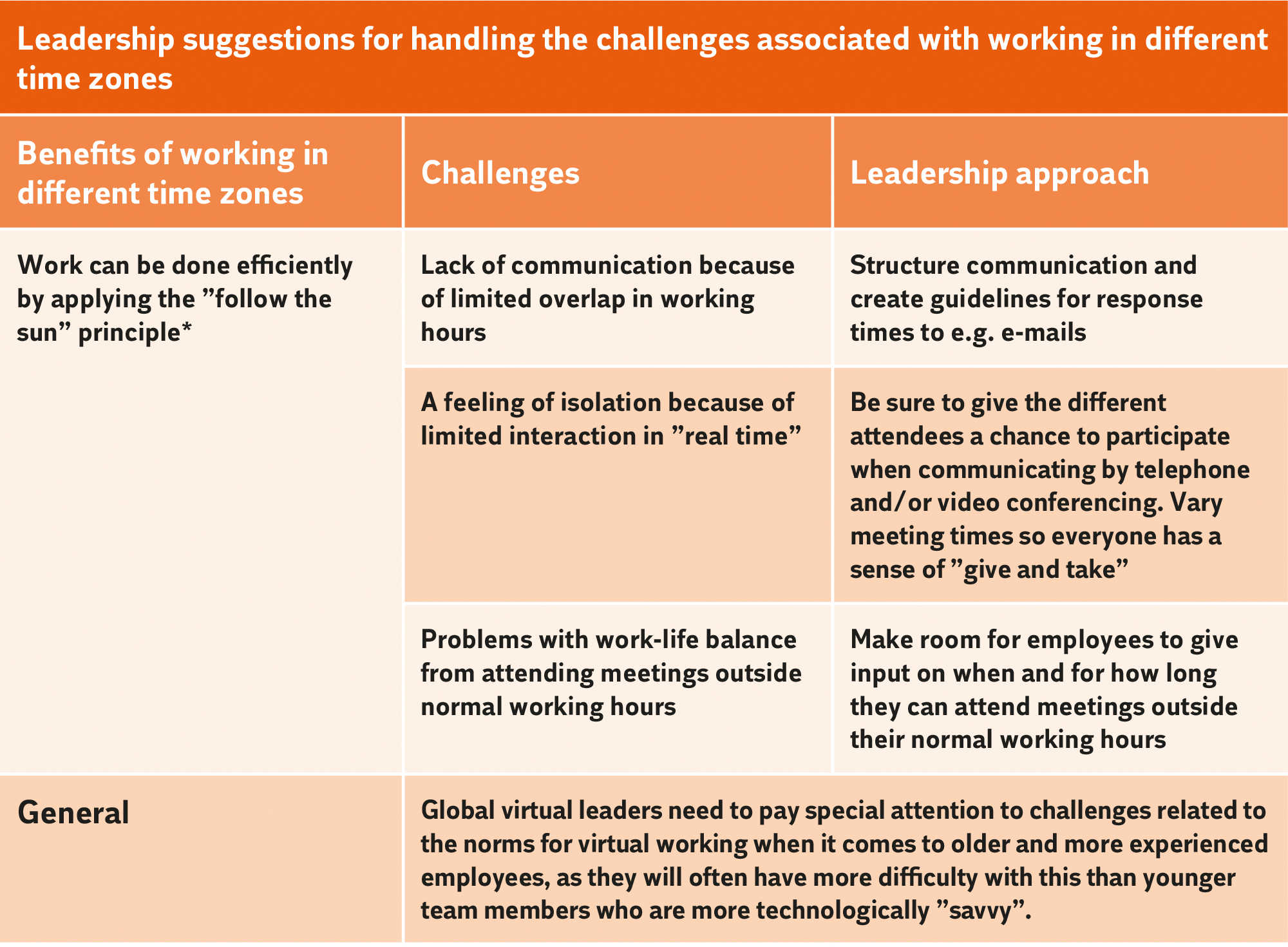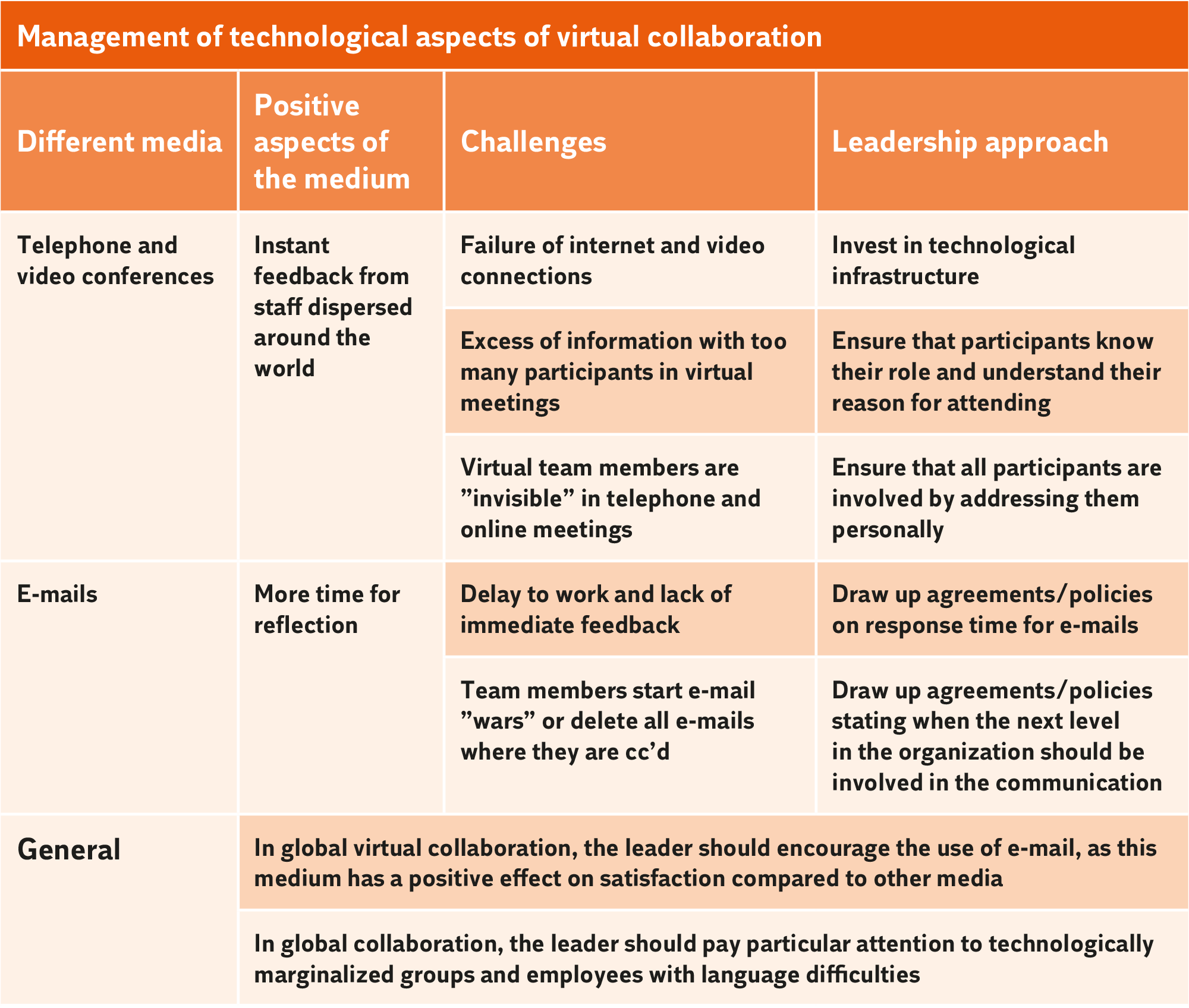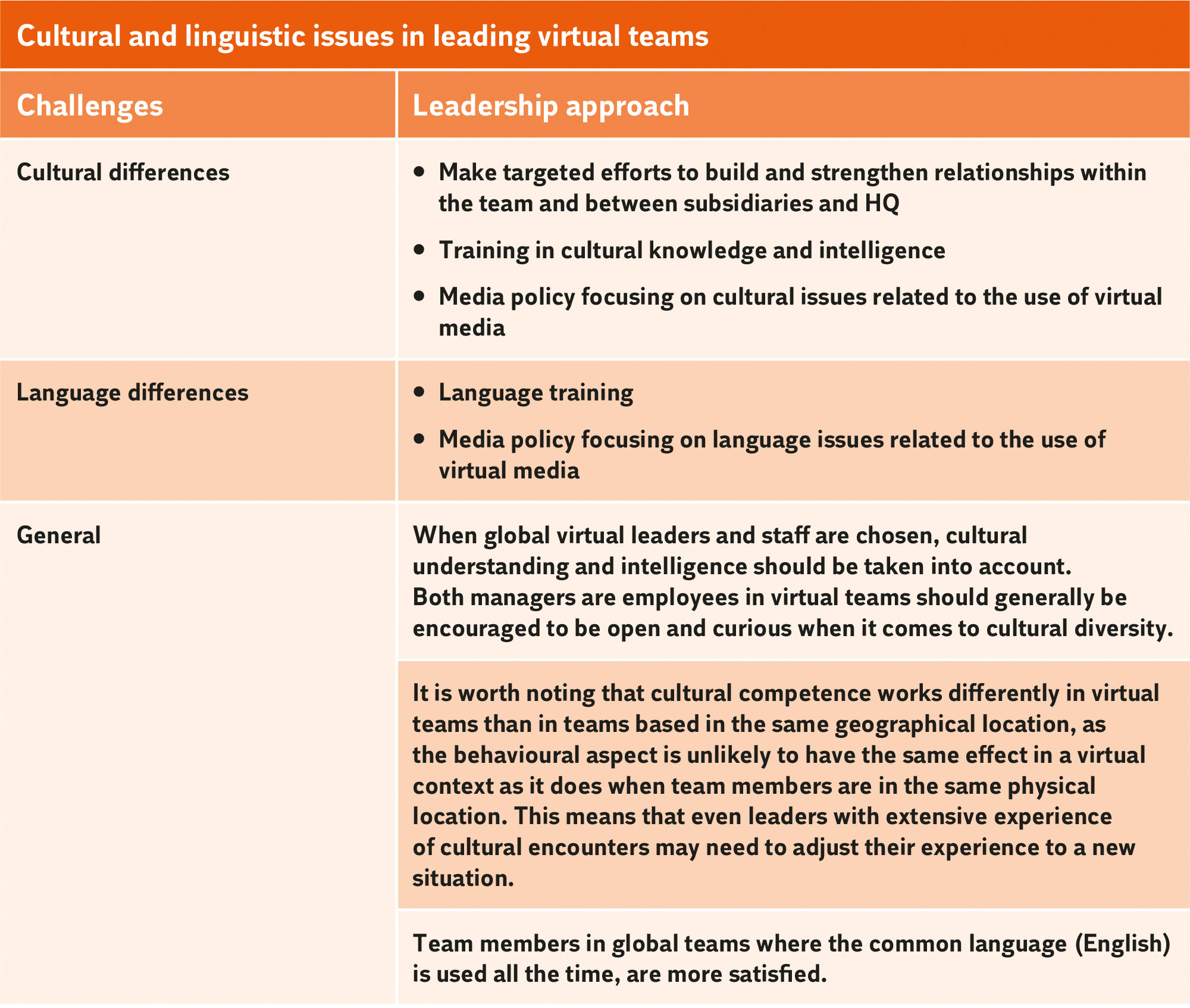Tool 7
Why: The use of technological tools such as e-mails, phone calls, video-conferences etc. is a fact of life for most leaders today. It is crucial for the global leader to be able to use these options to the best advantage, as they are lifeblood of dialogue with the staff, who are often dispersed around the world. This section focuses on some of the leadership issues that may be associated with leading via electronic media and other kinds of technological aid. Here global leaders will find a lot of good tips and suggestions for a process they can usefully go through with their teams in order to identify the framework and ground rules for the most effective virtual collaboration.
What: Virtual leadership is a name for the type of leadership exercised by technological means. Virtual leadership comes into play when the leader and the team members are physically remote from each other. There may often be time differences too, and virtual leaders then have to compensate for both physical remoteness and the fact that the collaboration often takes place outside normal working hours. In this sense, the conditions behind virtual leadership are very reminiscent of what we mean when we talk about distance leadership. And in practice, the two leadership disciplines will also be hard to tell apart.
How and who: The tool is intended for global leaders who are not based in the same location as their staff and are therefore dependent on the use of electronic media to discharge their leadership responsibilities. The tool and the process that it supports can best be used in close collaboration with the employees.
”Whatever happens, make sure you don’t break the connection”
(Global leader, Global Leadership Academy-seminar, November 2016)
The global workplace places demands on the ability of companies and leaders to coordinate activities across national borders. For the global leader, it is often a fact of life that their staff are dispersed in terms of geography, time zones and organization units. In theory, all members of the team could be working in every possible location and at all possible times of the day. Neither employees nor managers necessarily need to come in to a fixed address; they can work from airports, summer cottages, private homes or different company addresses. In practice this means that a significant part of the communication within the team has to be conducted via electronic media, mobile phones, video-conferencing etc. – what is nowadays called virtual collaboration. This is contrast to traditional collaboration and leadership where the manager and all of the team members are gathered in the same geographical location, work at the same times of day and can communicate directly with each other.
The global workplace can cause the individual employee to lose the sense of ”belonging”. There is also a risk of staff who are managed remotely, as opposed to employees who are in daily contact with their manager or colleagues, feeling that they have to find meaning in their work themselves, which places great demands on their ability to motivate themselves. For the global leader, it is then absolutely crucial to reduce this feeling of isolation and maintain a high level of motivation in every member of the team. In other words, the global leader needs to compensate for the deficits that arise when the team, including the leader, do not meet physically on a daily basis.
With all of the challenges that go with working in virtual teams, we may well ask why companies are practising this on a wider and wider scale. There are typically two general arguments in favour. First, virtual collaboration makes it possible to assemble (project) teams with a broad range of skills and cultural backgrounds. Globalization provides companies with access to a bigger pool of talent, and there can be many benefits in creating very diverse teams, as this helps to improve the quality of the solutions produced by the team. This assumes that the team is working well, and if the members of the team are spread across different locations, a special effort is required.
Secondly, there may be financial incentives to work in virtual teams. Every time a virtual meeting is held, the company saves money on air tickets and hotel accommodation for the attendees, as well as the time the participants spend travelling. If we look at these factors alone, there is every reason to hold all meetings virtually. However, this will quickly produce a management dilemma, as we also know that physical meetings are particularly effective in building trust within the team. Virtual collaboration may not necessarily replace the normal physical meetings, so a major task for the global leader is to strike a balance between physical and virtual meetings.
In practice, leaders who work virtually have to do the same job as managers who work in the same physical location as the rest of the team. Targets have to be defined and followed up, people have to be motivated, development advanced and priorities set. These activities can be challenging in themselves, but for the virtual leader, the geographical distance and time difference will increase the complexity of the leadership tasks. And this complexity will be all the greater if there are cultural differences between the members of the team.
Separation in time and space will simply mean that clear agreements, structure and discipline are even more important for collaboration than when we work in the same physical setting and at the same times. To address this, the global leader should lay down clear guidelines for practical collaboration. For example, there could be guidelines for response times in virtual working, clear agreements on how and when it is OK to contact each other outside normal working hours, and so on.
One way of maintaining motivation in the individual employee is for all team members to be invited to provide input to the guidelines to be laid down, and wherever possible, the wishes and needs expressed by every member of the team should be taken into account. In practice, however, it may be difficult if not impossible to accommodate all wishes and needs, so it is essential for the leader to communicate actively on the decisions taken when the framework for virtual collaboration is established.
To address the feeling of isolation and motivate every member of the team, global leaders of virtual teams should try to create a kind of global presence. This can be done with a leadership style which sets great store by detailed knowledge of the team’s work, setting clear objectives and holding a reasonable number of face-to-face meetings. The global virtual environment necessitates a flexible and proactive leadership style in order to accommodate the employees’ differing cultural backgrounds and overcome the geographical distance. Clear agreements should be made on how and when the leaders can be contacted, and the targets for the team as a whole and for the individual employees should be clear and transparent. If the virtual team is made up of people from different cultures, it is especially important for the leader to have an open and patient approach combined with strong cultural awareness.
There follows an overview of some of the challenges associated with working displaced from others in time and space, with suggestions for how these challenges can be addressed in terms of leadership:

Figure 7.1: Handling issues with remote collaboration
*The ”follow the sun” principle is a workflow in which daily tasks are passed on between employees/units located in different time zones. This means that the work never has to stop.
The technological challenges in virtual collaboration may be crucial to the ability of the team to produce the expected results. This makes it an aspect to be considered and handled alongside the other issues in virtual leadership and collaboration. In this connection, it is worth noting that training in the use of technological aids and developing the required skills are often underrated.

Figure 7.2: Management of virtual collaboration
The virtual environment has a tendency to magnify the challenges arising out of differences in national culture. This makes it especially important for global leaders working virtually to foster understanding of the differences that exist within a team made up of people of different nationalities. Experience shows that performance and satisfaction in teams which have decided that everyone should speak the same language at all times are higher than in teams working in many different languages.
Cultural differences affect the styles of communication used by the staff and the leader, and may also have a negative impact on the effectiveness of virtual teams if there is a lack of mutual respect and understanding of these differences. Cultural differences between team members can be addressed by giving training in cultural awareness and e.g. focusing on how the different cultures combine to affect the way in which we use and communicate in different media. Language difficulties are often more noticeable in phone calls because of differences in accent and vocabulary. This last can be addressed by increasing awareness of the relationship between language differences and the media used, and by providing language training.

Figure 7.3: Virtual teams – culture and language
If your position as a global leader requires you to work virtually, it is a good idea to involve your staff in a process of defining guidelines for how the collaboration should work in practice. Before you involve the team, you should think carefully about your ambition for the team, the results you need to produce and how you want this to be achieved. If it is at all possible, there is much to be said for gathering the team together physically to agree on the ground rules and guidelines.
In this section, we will present you with a process for working with your team, based on the issues you have considered, to lay down rules and guidelines to achieve your goal together. If you can get someone (a colleague or HR consultant) to help you to facilitate the process, this may help by allowing you to enter into the discussions that form the basis for the decisions on an equal footing with the rest of the team.
Step 1
Communicate your ambition for the work of the team in the coming period and the situation in which it is to be done. Be especially clear about the common objectives and (if you have not done so before the meeting) hold 1:1 (possibly virtual) sessions with each of the staff and communicate their targets to them clearly and precisely.
Step 2
The team formulates a shared purpose based in the global leader’s ambition and the team’s goals. Questions to assist in this might include:
Step 3
Based on the goals the global leader has formulated for the work of the team, the employees specify the concrete performance targets. Questions to assist in this might include:
Step 4
Based on the framework that has been communicated for the work, the team works to formulate shared attitudes/values defining how they intend to work together to achieve the agreed goals. Questions to assist in this might include:
Step 5
There should be agreements on roles and responsibilities in the team. Questions to assist in this might include:
Step 6
To build a shared commitment, agreements should be made on the obligations of the team members to each other. Questions to assist in this might include:
Step 7
To ensure that the team fulfils its agreements and mutual commitments, the collaboration should be evaluated as the work progresses. The team should agree on how to do this. Questions to assist in this might include:
Expectations of the global leader who has to succeed in a global environment are closely linked to the many other skills we discussed in the earlier chapters of this book. And remember that leadership is a collaborative effort. It is not something the global leader ”goes and does” to his staff. Good leadership is something you make together, and just as with traditional leadership, it is also important for the global employees to seek out what they need from each other and from their leader in their day-to-day work. If anything, it is even more important to remember this when the team is not together from day to day and the leader cannot so easily spot employees who are not happy, not performing or experiencing personal crises and/or successes and need some form of attention from management.
Lauring, J. & Klitmøller, A. (2014). Global Leadership Competencies for the Future. Virtual Collaboration. Global Leadership Academy – Danish Confederation of Industry and Copenhagen Business School.
Straub-Bauer, A. (2014). When a thousand kilometers separate manager and employee. GLA Insights, April 14, 2014.
Straub-Bauer, A. (2014). Virtual leadership skills. GLA Insights, January 12, 2014.